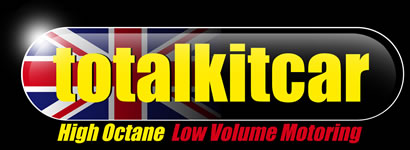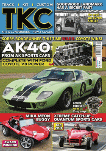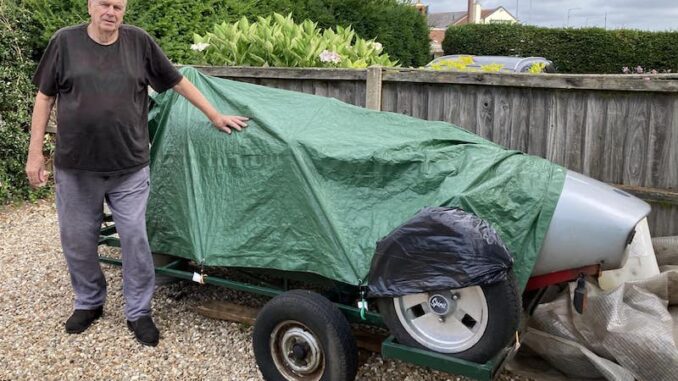
This week STEVE HOLE tells the story of a very underrated company making very underrated kitcars – HUDSON COMPONENT CARS
MORE IMAGES TO FOLLOW
The name Roy Webb will be familiar to you if you’ve been into kitcars and particularly three-wheeled kitcars since the nineties. He was the man behind the Hudson Component Cars marque based in Carrow Road, Norwich.
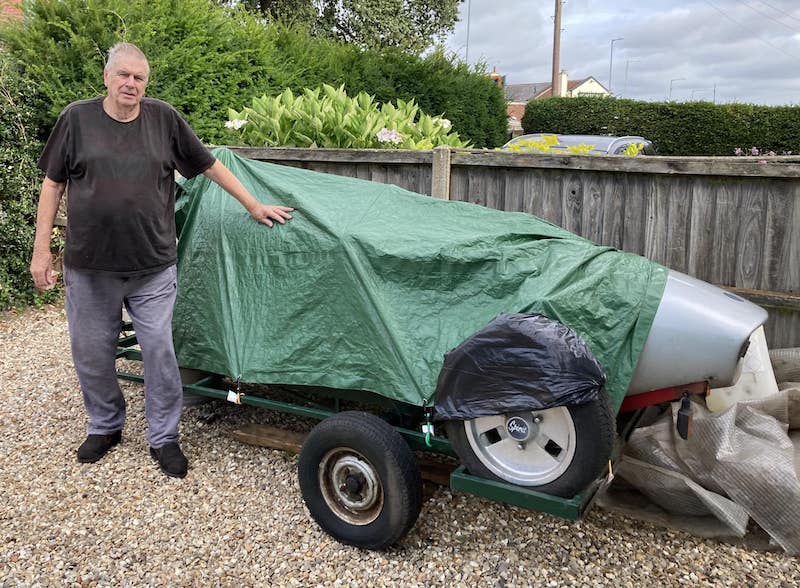
Roy Webb above pictured in 2023 with his first Hudsfon Free Spirit. Pic courtesy of Gill Webb
The company was active between 1990-2000 producing the Free Spirit, Kindred Spirit and four-wheeled Mystic.
However, if you are a drag racing fan, have a passion for stock cars and maybe into classic motorcycles, then the name will definitely be familiar.
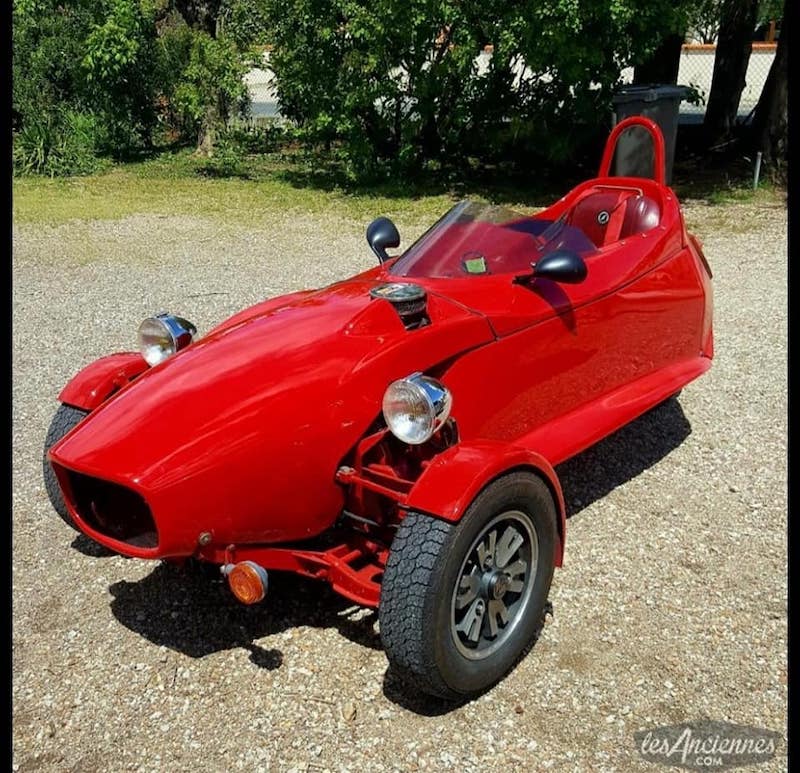
Image courtesy of lesanciennes.com
In drag racing terms Webb was a regular at venues such as Santa Pod during the seventies and eighties add best-known for achieving success in a bonkeres Competition Altered called ‘Spiderman’ (with a name like Webb he just had to be ‘spiderman’).
Scroll forward to 2025 and Roy’s son Julian competes in the same class in another version of ‘Spiderman’ and Roy acts as crew chief. The Webbs also now own a very famous jet dragster called Split Second. I believe that they also own – or did own – John Spufforth’s Hauser-built dragster called Cannonball.
I also seem to recall that Roy had a passion for mini motorcycles, Monkey bikes and the like, while his 150 strong collection of classic British motorbikes was superb.
I knew about the drag racing activities but then discovered that he’d also built a string of specials and hot rods and he also won a Custom Car magazine design competition in 1987 for an all-GRP-bodied Vauxhall Astra. He also built a canary yellow ‘shorty’ Mini with a roof chop.
The love of special’s led to a three-wheeler called Webb’s Wonder in 1989, which directly led him into the kitcar world when he productionised that car into the Hudson Free Spirit (the Hudson name might have been influenced by the American Hudson marque).
HUDSON FREE SPIRIT
The idea for the Free Spirit came after a friend of Roy’s was building a Lomax 223. Webb looked at the car, appreciated the concept, but felt that he could make something better and with more power than a 2CV could provide so he opted to use Renault 5 as the donor.
Sound thinking, as back in the nineties, Renault 5s were still very abundant and were available cheaply. Sound cars mechanically, brilliant suspension and with very strong engines but very iffy in terms of flimsy bodywork. Ideal, therefore, for kitcar use.
The car featured a tubular spaceframe chassis with panelled floor and bulkhead with an extended steering column (part of it was Austin Allegro) Renault engine in the front with the four-speed gearbox in front of the engine. Early 5s had a dashboard-mounted gearlever, which had a very stroppy gearchange. A rod ran up over the top of the engine where a single bend turned the rod downwards into the top of the gearbox. From 1973, the 5 had a floor-mounted gearlever.
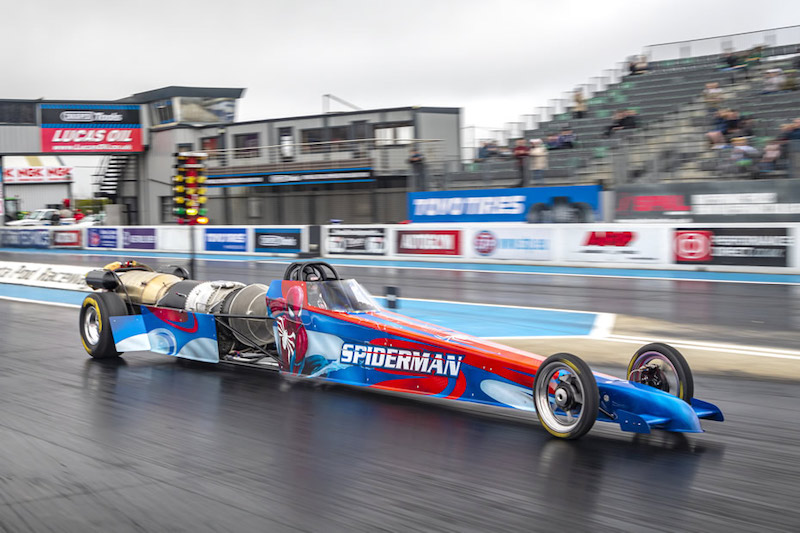
Here’s Roy and Gill Webb’s son, Julian in action at Santa Pod – Roy Webb drag raced a Competition Altered in the seventies and eighties also called Spiderman. Pic courtesy of Santa Pod.
Standard engine was the 1108cc (aka C1E 688) used in the Renault 4 and Renault 5L povrty-spec model. It only delivered an asthmatic 45bhp (it had a little Zenith 32if7 carburettor) but in the single-seat Free Spirit weighing less than 400kg it was enough to give an enthusaistically driven hot hatch driver a hard time.
Thoughts of tuning the 1108cc unit were fruitless other than polishing the ports. Most customers settled for the 1289cc unit from the Renault 5 TS, LS and GTL from April 1974 and derived from the Renault 12 of 1965. This was a straightforward fit (or staright swap for the 1108cc) and gave a hike of 20bhp. This made a hugh difference in a Free Spirit.
Front suspension as standard renault 5 with the exception of coil-over dampers, while at the back it used one of the Renault 5 donor’s rear trailing arms reversed and centralised with a coil-over damper.
Hudson Components, located in Norwich were based on Carrow Road, the same road as Norwich City Football Club, which was very close. I won’t name the kitcar journalist (it wasn’t me!) who was parked in front of then Norwich manager Mike Walker and backed into his company top of the range Mercedes-Benz. Luckily not much damage was done.
The Webbs may have sold around seventeen Free Spirits. When they decided to move on, a company called Wizard Cars acquired the projects and kept them until 2003. There is some conjecture as to whether he ever made one.
Hudson Component Cars 1990-2000
Wizard Cars 2000-2003
Approx 17 made
HUDSON KINDRED SPIRIT
In 1992, primarily due to customer demand from people who wanted to take their mate, child or maybe even wife/girlfriend out for a blast.
Roy Webb added a second seat, in tandem layout by adding 12in to the chassis length. Otherwise the specification, donor and engine choice were exactly as per the Free Spirit. This model dominated sales with maybe around 125 of these sold.
Hudson Component Cars 1992-2000
Wizard Cars 2000-2003
Approx 125 made
HUDSON MYSTIC
Roy Webb, wife Gill and their son, Julian (now a top UK drag racer) devised the Mystic as a more modern take on their Free and Kindred Spirit themes, albeit with four wheels.
The naming was clever. This was down to Gill Webb. A mystic communicates with spirits!
There were mechanical similarities with the other Hudson models, such as sharing the same nosecone. Originally devised as a single-seater, I believe that Webb later devised a tandem a la Kindred Spirit arrangement.
Front cycle wings were wider while the front end was similar to the other Hudson models with trailing arms and torsion bars. There were double wishbones at the rear with R5 torsion bars. Spax dampers were used all round. The chassis was a tubular steel spaceframe with sheet steel bracing on the floor and front bulkhead. A pre-1992 Renault 5 donor was preferred.
Those angled side air intakes were dummies and did nothing other than look good. The prototype had a fixed front two-piece venturi spoiler although Webb later devised a mechanism using a wiper motor that meant the driver could angle them from the cockpit.
The huge rear spoiler at the rear surely did nothing other than give an asethetic enhancement and it did look good. It was an optional extra, but I think all three built had it fitted.
Whereas the Spirit models featured a five-piece GRP body the Mystic’s was a one-piece main tub and separate nosecone and like them the quality of glassfibre was first class. It also used the Renault 5’s petrol tank (the Free and Kindred spitirs didn’t and used a bespoke one instead).
A true single donor car right down to the instruments, one of the only major components it didn’t plunder from the R5 was the radiator, which Webb didn’t think was up to the job. Instead, he had a local company modify an Austin Maxi radiator and used it on the Mystic turned 90-degrees aboved the gearbox.
However, it did use the standard R5 hoses for cooling and the like. The Free- and Kindred Spirits which had a snakes nest of aftermarket hoses wrapped in out out of the exhaust manifold.
Hudson Component Cars could supply stuff like seat(s) and headlights (Hella square units) if the customer preferred although customers could and often did go their own way. The Citroën 2CV often donated its lights. The rubber mounted Yamaha front indicators were used most often but again weren’t included in the kit.
Like the other Hudson models, the gearlever was mounted between the driver’s legs. It sounds odd, but you get used to it really quickly.
I drove several Free and Kindred Spirits over the years but not a Mystic. I found the threes to be excellent. They handled well, I remember, light and agile and (please forgive this) ‘spirited’ performance. My colleague Ian Hyne described the Mystic as ‘go-kart-like’ which kind of works well, I think.
Mystic kits cost £1950 (£400 more than the Kindred Spirit’s package) and were quite complete. All you needed, over and above the aforementioned seats, maybe the headlight units, front indicators, spoilers and a steering wheel. Roy Webb reckoned that a DIY-build Mystic could be completed for as little as £2500 on a real budget.
